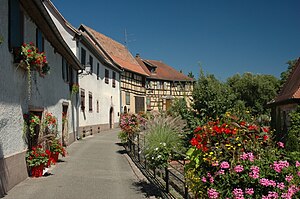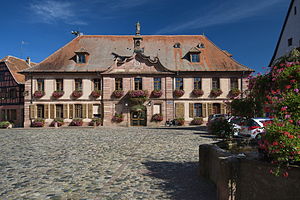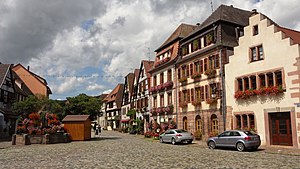 | ||
| Bergheim | ||
| region | Grand Est | |
|---|---|---|
| Residents | 2.096 (2018) | |
| height | 211 m | |
| Tourist info | 33 (0)3 89 73 23 23 http://www.ribeauville-riquewihr.com | |
| no tourist info on Wikidata: | ||
| location | ||
| ||
.svg/250px-Blason_de_la_ville_de_Bergheim_(68).svg.png)


1. Old linden tree
2. Obertor (Porte Haute)
3. Marketplace
4. Vine market
5. Town Hall
6. Information board
7. Old Synagogue
8. Church
9. Witch House
10. City library
11. Post Office
12. German military cemetery
Bergheim is a french Commune in the department Haut-Rhin, in the Alsace on the Alsatian Wine Route (Alsace Wine Route (Route des vins d'Alsace)). She is a member of the community association Pays de Ribeauvillé and Riquewihr. Ribeauvillé (German Rappoltsweiler, Alsatian Rappschwihr) lies adjacent in the foothills of the Vosges at the entrance of the Strengbach valley.
Bergheim is one Ville fleurie, a "flower-adorned city" and carries im Concours des villes et villages fleuris ("Competition of cities and towns decorated with flowers") 4 out of 4 roses.
background
Something about the story
Bergheim was already settled in Roman times, which is evidenced by a large mosaic from Roman times uncovered in 1848, which is now in Musée d’Unterlinden in Colmar exhibited is; in 2006 another followed. During the Frankish rule (465) the place was called Berchem. After belonging to the Duchy of Alsace, the Bergheim domain became the property of the Abbey of Moyenmoutier in Lorraine. Then it came into the possession of the Archdiocese of by exchange Toul and became the property of the Dukes of Lorraine. In the Middle Ages, Bergheim was a free city of rule Rappoltsweiler (House Ribeaupierre). Henry II of Ribeaupierre had the fortifications of the now in 1312 Bercheim hot place. In 1313 the city received the right to mint money and levy customs duties. The Ribeaupierres sold the place to the House of Habsburg. Two new names appeared for the city in 1510 and 1576: Berckheim and Berken. In the 17th century it fell to King Louis XIV and in the 18th century again to the Ribeaupierres until the French Revolution.
coat of arms
Blazon: (Source: here)
- D'argent à deux tour carrées pavillonnées de gueules maçonnées de sable et enfermées dans une enceinte ronde de murailles crénelées aussi de gueules, maçonnée et ouverte de deux portes de sable, un montui de trois coupeaux de sinople posé du milieu sommé d'un écusson d'azur à trois fleurs de lys d'or
getting there
By train
The next station "Ribeauvillé" in the industrial area on the way to Guémar is now out of order. The nearest train stations with a TGV stop are in Sélestat and Colmar.
In the street
The journey takes place by car
- from north and south over the
 Alsacienne auto route, N 83,
Alsacienne auto route, N 83,  19 or 20 Bergheim-Ribeauvillé, then following the signs straight to the village.
19 or 20 Bergheim-Ribeauvillé, then following the signs straight to the village. - from the west from inland (Sainte-Marie-aux-Mines) about the D 416 to Ribeauvillé and then following the signs to Bergheim.
- from the east: The next Rhine crossing to Germany is at Marckolsheim (20 km)
mobility
&groups=Maske,Track,Aktivitaet,Anderes,Anreise,Ausgehen,Aussicht,Besiedelt,Fehler,Gebiet,Kaufen,Kueche,Sehenswert,Unterkunft,aquamarinblau,cosmos,gold,hellgruen,orange,pflaumenblau,rot,silber,violett)
The Grand'Rue, which runs through the town from east to west, only has an incline of 10 m at around 500 m, which is easy for pedestrians to manage.
Tourist Attractions


The place is one of the places in the region that fortunately was hardly damaged by the effects of war during the world wars. In the main street Grand'Rue, which cuts through the middle of the rectangular village from east to west, and in its side streets and alleys, you will find a multitude of beautiful and remarkable half-timbered houses and other sights. Not all of them can be listed here, so only a selection. A visit to the place during a stay in Alsace is highly recommended.
Towers, upper gate and city wall
The place has a double fortification wall, between which a moat ran, which is now filled with gardens. In the north runs an outer ditch, traversed by the Bergenbach. On the NE side you can still see a ditch embankment wall. The city could be entered through four gates from all four directions. However, it is only that Porte Haute The remaining three gates were demolished in the 19th century to allow access for larger cars. The city fortifications still have eight semicircular and one square watchtower.
The main threat to the place was to be expected from the north, which is why nine flanking towers were built here. The flanking towers protrude from the defensive wall as defensive towers on the field side. From the defense platform and the still well-preserved loopholes in the tower, the section of the wall in between could be swept on the side with long-range weapons. The towers have a semicircular or square plan.

- 1 Tour carrée - The square tower is one of the oldest towers in the city.
- 2 Tour de la Sorcière (Witches Tower) - Nice steep-fire embrasure. The rear wall of the ditch embankment can also be seen here.
- 3 Tour au Pan de Bois (lattice tower) - Shows a cantilevered floor. When the walls of the towers could no longer withstand the new firearms from the 17th century, the towers were converted for residential purposes.
- 4 Tour de la Poudrière (Powder Tower) - With a Lombard frieze, a porch and various loopholes for archers and for 2 cannons as well as three beak-shaped eaves.
- 5 Tour driver - The "driver's tower" comes from the 14th / 15th centuries. Century.
- 6 Tour Wotling - The "Wotling Tower" forms the flanking of the inner fortification wall.
- 7 Tour Deiss - The "Deiss Tower" is built over by a house that is still inhabited today.
- 8 Porte Haute - The Obertor is the last of the four city gates that have been preserved. The Gothic gate has a round arch portal and a roof with painted bricks in a Burgundian pattern. While the landside facade looks rather uninviting, the half-timbering of the city-side facade can be described as pretty.
Houses, streets, squares
- 9 Vieux Tilleul - The linden allegedly planted before 1300 is said to be the oldest tree in Alsace. From 1300 folk festivals took place under the linden tree, which is still in bloom today. Today their heavy branches have to be supported by supports. The linden tree stands on the edge of the city garden, on the SE side of the roundabout in front of the Obertor.
- 10 44 Grand'Rue - On the wall of house 44 Grand'Rue you can marvel at a magnificent sundial from 1711, which was renovated in 1959 and 1977. As one of the most beautiful sundials in Alsace, it shows - of course only when the sun is shining - the hours, the change of seasons, the respective signs of the zodiac, the date and the times of the sun's rise and set. (Picture 15 in the right gallery "Pictures from Bergheim")
- You now go to the right rue de la Monnaie ("Munzenstrasse"), whose name reminds us that Bergheim was once the Mint right owned. Archduke Leopold of Austria confirmed in 1375 (see also: Evil Mardi Gras) in a charter to the Bergheimers that they would forever have the right to appoint a mint master to mint coins and spend pennies could.
- A few meters further on you meet them Place du marché aux échalas, the "market of the grapevines", where they were once traded.
- At the end of the square at the confluence with the Rue des Vignerons ("Winzerstraße") there is a pretty fountain.
- 11 55 rue des Vignerons - House No. 55 on Winzerstraße is right across from the aforementioned fountain and has two gates from the 16th century in its green facade, a large arched gate for horse and ox carts. It bears the peasant's guild mark (a plow) and the Bergheim coat of arms. The second gate, more likely only intended for the passage of people, is in the Renaissance style Basket bow with chiseled decorations, grimaces and plant motifs. The house was originally a tithe farm of Hungary before it became a working farm. (Picture 9 in the right gallery "Pictures from Bergheim")
- Now go left in the Winzerstraße to the branch off to the left Rue de la Croix ("Kreuzstrasse") and go to Place du Docteur Pierre Walter ("Dr.-Pierre-Walter-Platz").
- 12 Mairie - The building on the right was built in 1767 during the Ancien Régime under Louis XV built as a council chamber. After the French Revolution, it was converted into today's town hall. The baroque sandstone facade bears an image of the Greek goddess of justice, order and philosophy, Themis, and is a reminder of the jurisdiction of the former city council. (Picture 5 in the right gallery "Pictures from Bergheim")
- On the left you can see a beautifully decorated fountain with the coat of arms of Bergheim, it is from the year 1721. (Picture 8 in the right gallery "Pictures from Bergheim")
- Opposite you can see at house number 8 the main facade from the 18th century with uniform window frames with baroque motifs. (Pictures 8 and 14 in the right gallery "Pictures from Bergheim")
- To the right of this is house number 6 with a jagged gable, typical of the Rhineland architecture of the 15th and 16th centuries. It has sandstone-framed windows and lintels with carved upside-down scallops. (Picture 22 in the right gallery "Pictures from Bergheim")
- 13 11 place du Docteur Pierre Walter - House number 11 on the left was mentioned as early as 1423. It was formerly the council building of the winegrowers' guild. The current building dates from the beginning of the 18th century. (Picture 21 in the right gallery "Pictures from Bergheim")
- To the left of the town hall begins Rue des Juifs ("Judenstrasse") with the synagogue.
- 14 Synagogue - It was built from 1860 to 1863 in neo-Romanesque style on the site of three previous synagogues. It bears witness to the formerly large Jewish community of the village, in which, for example, 68 families of Jewish faith lived in 1784 and 513 people in 1838, about 15% of the population. Today only 2 Jewish families live in Bergheim. In the absence of enough churchgoers, the synagogue was profaned in 1992 and has been used for cultural events ever since. It is the only synagogue in Alsace that still stands where its predecessors were built in the 14th century. (Picture 24 in the right gallery "Pictures from Bergheim")
- Back to Place du Docteur Pierre Walter. At the far end of the square opens from the right Rue du Haut-Koenigsbourg a.
- 15 Maison du Sabotier - The people of Bergheim call this house on the corner the "house of the wooden shoemaker". It is from 1617 and bears the guild mark of an armorer (crossed swords). There is a beautiful wooden gallery on the first floor. On picture 12 in the right gallery "Pictures from Bergheim" lying in the shade.
- To visit the church, go back to the Grand'Rue.
- 16 8 Grand'Rue - The completely bricked house No. 8 in the Grand'Rue has already served many purposes: a cloth dyeing, a spinning mill and a workshop for factory-made products were housed here. Today it is a residential building. (Picture 23 in the right gallery "Pictures from Bergheim")
- Across the street, at the junction of the Rue du Maire Funny ("Bürgermeister-Witzig-Straße"), there is a very nice half-timbered building (picture 20 in the right gallery "Pictures from Bergheim")
- 17 Église Notre-Dame de l'Assomption - In the place of today's "Maria-Himmelfahrtskirche" there must have been a church consecrated to the Mother of God as early as 700, according to the archives. Except for the "Green Tower" (Tour verte), the bell tower, destroyed in 1287. From then on, the tower served as a watchtower, ossuary and chapel until the beginning of the 19th century, when it was also demolished. The current church was consecrated in 1347. From this construction period, the vaulted choir, the sacristy with cross-pointed vault, the three-part nave, the bell tower and a portal carved out of stone are still preserved. Another sacristy to the south and a chapel were added in the 19th century. Inside the church there are still beautiful wall paintings from the Middle Ages, frescoes from the 14th century, multi-colored wooden statues from 1480, a painting from 1616 and the organ restored in 2006. The exterior of the church is also exceptional in its furnishings: the western gable shows the only Alsatian depiction of the Adoration of the Magi. This half-relief is made of sandstone and dates from the 14th century, the north and south walls show the Descent from the Cross.
- Near the church, at 5 place de l'Église, is the former ossuary, which was built from 1549-1550 and served as a boys' school from 1767 to 1970. Today the house with a beautiful renaissance facade houses the "witch house" (Maison des Sorcières).
kitchen
As usual, the cuisine in the restaurants is regional-Alsatian. The Tourist information website lists some restaurants to choose from. In addition, there are a number of winstubs (wine bars), in which not only wine is served, but also typical small Alsatian dishes.
Events
accommodation
What has been written about the kitchen also applies to the accommodations.
Practical advice
- Office de Tourisme Pays de Ribeauvillé et Riquewihr, 68153 Ribeauvillé. Tel.: 33 (0)3 89 49 08 40, Fax: 33 (0)3 89 49 08 49, Email: [email protected].
trips
If you still have the time and leisure with the abundance of worth seeing objects, the place is an ideal starting point for the other really worth seeing places of the association, but also for tours in the Vosges, to Colmar, Strasbourg Etc.
literature
Web links
- http://www.ville-bergheim.fr - Official website of Bergheim
- Tourist office of the Ribeauvillé-Riquewihr municipal association















_-_2.jpg/300px-Bergheim,_cadran_solaire_peint_(_1711_)_-_2.jpg)



















